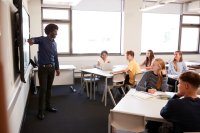Using a Social Media Account With Your Class
Students can learn how to use social media responsibly through teacher modeling and shared responsibility for posting.
Given the reality that most teens have smartphones and use social media daily, how can schools help support digital citizenship and the ethical and responsible use of technology in our schools?
One solution is a class social media account—an account created by the teacher and students together that provides students with opportunities to practice digital citizenship in context, with a teacher’s mentorship, and teaches digital literacy skills while countering the idea that social media is only for entertainment. I’ve seen kids as young as 5 help make decisions about what photos or learning artifacts should be posted to the class account, and the results have been very positive.
Setting Up for Success
There are several things to take into account to ensure that a class social media account is a positive learning space. First you have to decide on a platform. It might help to poll parents and guardians to see which platform(s) most of them already use, since they’ll be part of your audience.
Next you need to decide on the purpose of the account with your class. What will you post, and how often? How will you manage the posting? Even as early as kindergarten, kids can determine what to share, and teachers can gradually release responsibility as students get older. You can release responsibility to individual students or student committees that rotate.
After creating a class name, profile, and header with your students—so they feel like they have ownership of the account—review responsible use of technology and social media and reinforce ways they can lead in online spaces. It’s also important to follow accounts of other classes and organizations, which will provoke curiosity and learning.
Some educators post the learning of the day as a way of communicating with parents. But why not have students pick what will be shared? It can begin with the prompt: “Let’s look at the pictures we’ve taken today that capture our learning. Which should we share? What should we say about this?” This helps students reflect with you and reinforces lessons about appropriate posting.
Have a plan for what you will do together if you see something problematic. This can be as simple as asking students, “What’s our plan if someone we’re following posts something inappropriate?” The likelihood of this happening is small if you’re careful about who you’re following to begin with.
Parental Consent and Involvement
Share the details of the account with parents—see two sample letters here. Let them know that you feel it’s important to model what communicating online looks like, and that student privacy is very important to you.
It’s important to make parents a part of the conversation and respect their right to keep their kids offline. When this happens, it’s a wonderful learning opportunity for kids. You can have students participate without sharing their names or photos. You can also explore the many editing tools that blur or disguise photos, and help kids develop a culture of permission and respect for online privacy.
It may also be worthwhile to host a learning event for parents and students so that you can learn about your chosen platform together.
Uses for a Class Social Media Account
Learning course content: Many students think about social media only as a place for entertainment, yet it can be a great tool for learning. @MathInTheNews, for example, posts math questions on Twitter that are based on current events. And using your class account to ask an author or a scientist a question shows kids a way to use social media to satisfy their curiosity about things they’re learning.
Developing digital citizenship: A class account presents a teacher with the opportunity to reinforce important digital citizenship and digital literacy lessons that students may not be getting at home. One strategy is to discuss questions as they arise from content you’re seeing. What is sponsored content? If students see information that doesn’t seem to be correct, how can they check? How can the words and tone of a post be misunderstood?
Spreading kindness: When I created a hashtag for a young girl in our community who was diagnosed with a rare form of cancer, I was amazed by the number of educators who, with their students, shared letters, videos, pictures, and even jokes to the hashtag to brighten her day. As a result, I’m always on the lookout for ways to show kids how to use online spaces to spread kindness. This can combine in-person and online connections. For example, we connected online with a local organization that collected and distributed cards for kids in long-term hospital care.
Wouldn’t it be wonderful if students had opportunities to see social media as a way to make a positive difference in someone’s life?
Connecting with faraway peers: Social media can introduce your students to peers far beyond your school. For example, I’m a mentor for the Global Educational Student Chat (a Twitter chat led by students for students), where student leaders pick a topic and have a conversation about it every month. Follow @GlobalEdSsChat on YouTube Live or Twitter so your students can join the conversation. They can become guest panelists or help us pick our next topic.
A class social media account can help your students see what appropriate online interactions can look like and give them a way to learn with the world.
